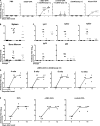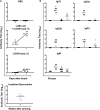Antigen targeting to dendritic cells elicits long-lived T cell help for antibody responses
- PMID: 16505139
- PMCID: PMC2118236
- DOI: 10.1084/jem.20051639
Antigen targeting to dendritic cells elicits long-lived T cell help for antibody responses
Abstract
Resistance to several prevalent infectious diseases requires both cellular and humoral immune responses. T cell immunity is initiated by mature dendritic cells (DCs) in lymphoid organs, whereas humoral responses to most antigens require further collaboration between primed, antigen-specific helper T cells and naive or memory B cells. To determine whether antigens delivered to DCs in lymphoid organs induce T cell help for antibody responses, we targeted a carrier protein, ovalbumin (OVA), to DCs in the presence of a maturation stimulus and assayed for antibodies to a hapten, (4-hydroxy-3-nitrophenyl) acetyl (NP), after boosting with OVA-NP. A single DC-targeted immunization elicited long-lived T cell helper responses to the carrier protein, leading to large numbers of antibody-secreting cells and high titers of high-affinity antihapten immunoglobulin Gs. Small doses of DC-targeted OVA induced higher titers and a broader spectrum of anti-NP antibody isotypes than large doses of OVA in alum adjuvant. Similar results were obtained when the circumsporozoite protein of Plasmodium yoelii was delivered to DCs. We conclude that antigen targeting to DCs combined with a maturation stimulus produces broad-based and long-lived T cell help for humoral immune responses.
Figures




Similar articles
-
OVA-bound nanoparticles induce OVA-specific IgG1, IgG2a, and IgG2b responses with low IgE synthesis.Vaccine. 2014 Oct 14;32(45):5918-24. doi: 10.1016/j.vaccine.2014.08.059. Epub 2014 Sep 6. Vaccine. 2014. PMID: 25211769
-
Affinity maturation without germinal centres in lymphotoxin-alpha-deficient mice.Nature. 1996 Aug 1;382(6590):462-6. doi: 10.1038/382462a0. Nature. 1996. PMID: 8684487
-
The administration route is decisive for the ability of the vaccine adjuvant CAF09 to induce antigen-specific CD8(+) T-cell responses: The immunological consequences of the biodistribution profile.J Control Release. 2016 Oct 10;239:107-17. doi: 10.1016/j.jconrel.2016.08.034. Epub 2016 Aug 26. J Control Release. 2016. PMID: 27574990 Free PMC article.
-
Boosting antibody responses by targeting antigens to dendritic cells.Trends Immunol. 2012 Feb;33(2):71-7. doi: 10.1016/j.it.2011.10.007. Epub 2011 Dec 6. Trends Immunol. 2012. PMID: 22153931 Review.
-
Targeting Conventional Dendritic Cells to Fine-Tune Antibody Responses.Front Immunol. 2019 Jul 4;10:1529. doi: 10.3389/fimmu.2019.01529. eCollection 2019. Front Immunol. 2019. PMID: 31333661 Free PMC article. Review.
Cited by
-
STAT3 signaling modulates the immune response induced after antigen targeting to conventional type 1 dendritic cells through the DEC205 receptor.Front Immunol. 2022 Oct 18;13:1006996. doi: 10.3389/fimmu.2022.1006996. eCollection 2022. Front Immunol. 2022. PMID: 36330518 Free PMC article.
-
Optimization of multi-epitopic HIV-1 recombinant protein expression in prokaryote system and conjugation to mouse DEC-205 monoclonal antibody: implication for in-vivo targeted delivery of dendritic cells.Iran J Basic Med Sci. 2015 Feb;18(2):145-52. Iran J Basic Med Sci. 2015. PMID: 25810888 Free PMC article.
-
Evaluation of an α synuclein sensitized dendritic cell based vaccine in a transgenic mouse model of Parkinson disease.Hum Vaccin Immunother. 2015;11(4):922-30. doi: 10.1080/21645515.2015.1012033. Hum Vaccin Immunother. 2015. PMID: 25714663 Free PMC article.
-
Understanding natural herpes simplex virus immunity to inform next-generation vaccine design.Clin Transl Immunology. 2016 Jul 29;5(7):e94. doi: 10.1038/cti.2016.44. eCollection 2016 Jul. Clin Transl Immunology. 2016. PMID: 27525067 Free PMC article. Review.
-
Targeting of antigens to skin dendritic cells: possibilities to enhance vaccine efficacy.Immunol Cell Biol. 2010 May-Jun;88(4):424-30. doi: 10.1038/icb.2010.39. Epub 2010 Apr 6. Immunol Cell Biol. 2010. PMID: 20368713 Free PMC article. Review.
References
-
- Banchereau, J., F. Briere, C. Caux, J. Davoust, S. Lebecque, Y.J. Liu, B. Pulendran, and K. Palucka. 2000. Immunobiology of dendritic cells. Annu. Rev. Immunol. 18:767–811. - PubMed
-
- Lanzavecchia, A., and F. Sallusto. 2001. Regulation of T cell immunity by dendritic cells. Cell. 106:263–266. - PubMed
-
- Liu, Y.J. 2001. Dendritic cell subsets and lineages, and their functions in innate and adaptive immunity. Cell. 106:259–262. - PubMed
-
- Guermonprez, P., J. Valladeau, L. Zitvogel, C. Thery, and S. Amigorena. 2002. Antigen presentation and T cell stimulation by dendritic cells. Annu. Rev. Immunol. 20:621–667. - PubMed
Publication types
MeSH terms
Substances
Grants and funding
LinkOut - more resources
Full Text Sources
Other Literature Sources
Miscellaneous

